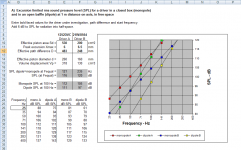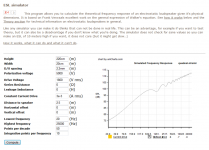Hi i remember there was this calculator for planarspeakers in general but mostly based on ESL but it could be used for planar magnetics to. you could calculate MAX spl at a frequency depending on xmax and surface area.
any one have that link somewhere >? i cant seem to find it. as far as i know it was on a site about quads i believe.
any one have that link somewhere >? i cant seem to find it. as far as i know it was on a site about quads i believe.
I think this is rather complicated. You can calculate how much air is moved but you will have to include the frequency response and the baffle size too. A low frequency driver cannot move a lot of air and the low frequency peak necessary to counteract the cut-off around the baffle will take up a lot of the limited excursion for the diaphragm/membrane. There will also be a limit of how much the Mylar (or similar) can strech, further reducing the SPL.
An exemple:
My Magnepan Tympani IVa will move about 0.8 L each side. For one speaker that is about 108 dB at 30 Hz minus the cut-off around the baffle. In order to reproduce low bass, a very large driving area will be needed.
An exemple:
My Magnepan Tympani IVa will move about 0.8 L each side. For one speaker that is about 108 dB at 30 Hz minus the cut-off around the baffle. In order to reproduce low bass, a very large driving area will be needed.
For acoustically transparant ESLs there are Frank Verwaal's Pascal and Matlab programs, but those are meant specifically for ESLs: Elektrostatic Loudspeakers
Hi Wrinex
The equation you speak of is the Walker equation, which applies to electrostatic speakers and relates SPL to membrane voltage, input voltage, stator spacing and distance to listener. A number of papers describe it, Baxandall's chapter from Borwick is probably best. PM me if you need a copy.
I'm not aware of a similar equation for magnetic planars.
best wishes
The equation you speak of is the Walker equation, which applies to electrostatic speakers and relates SPL to membrane voltage, input voltage, stator spacing and distance to listener. A number of papers describe it, Baxandall's chapter from Borwick is probably best. PM me if you need a copy.
I'm not aware of a similar equation for magnetic planars.
best wishes
Hi Wrinex
The equation you speak of is the Walker equation, which applies to electrostatic speakers and relates SPL to membrane voltage, input voltage, stator spacing and distance to listener. A number of papers describe it, Baxandall's chapter from Borwick is probably best. PM me if you need a copy.
I'm not aware of a similar equation for magnetic planars.
best wishes
Thanks golfnut. yes it might have been that one. far often as usually it is about relations. so keeping the voltages the same it can be transalted to a planar magnetic. not in forces but just in moving air with a given surface area.
but i think i might be able to find it with this information. ill give it a search tomorow
TRHAnks!
You could start with looking at the site I referred to, Frank Verwaal's calculations are all based on Walker's equation.
i know, but i am rather terrible with math
If you are after an estimate of max SPL capability vs frequency based on area and Xmax the spreadsheet geraldfryjr posted is a good guideline to manage your expectations as to what SPL is possible. It comes from Section 4 - Excursion-limited SPL Nomographs about 2/3 the way down Linkwitz publication page here: Linkwitz-Publications which will be kept alive for the foreseeable future.
Linkwitzlab Website down?
RIP Siegfried Linkwitz
Note that both the monopole and dipole calculations are based on point source models, so nearfield effects from large radiating area planars will not be captured. Still…a useful sanity check for obtainable SPL. The effective path difference “D” in the spreadsheet for dipole calculations should be set to the width of the planar or the width of the baffle if applicable.
You might have also been thinking of Arend-Jan’s online ESL Simulator(pic #2) which sadly no longer available. Belated RIP: Arend-Jan
You can see the webpage on the "Wayback" machine, but the simulator itself does not seem to function.
Electrostatic Loudspeaker (ESL) Simulator
Linkwitzlab Website down?
RIP Siegfried Linkwitz
Note that both the monopole and dipole calculations are based on point source models, so nearfield effects from large radiating area planars will not be captured. Still…a useful sanity check for obtainable SPL. The effective path difference “D” in the spreadsheet for dipole calculations should be set to the width of the planar or the width of the baffle if applicable.
You might have also been thinking of Arend-Jan’s online ESL Simulator(pic #2) which sadly no longer available. Belated RIP: Arend-Jan
You can see the webpage on the "Wayback" machine, but the simulator itself does not seem to function.
Electrostatic Loudspeaker (ESL) Simulator
Attachments
I had posted a Walker equation equivalent for true ribbons here: DIY ribbon dipole tweeter, reductio ad minimum…I'm not aware of a similar equation for magnetic planars.
Similar equation could certainly be derived for magnetic planars based on total area and equivalent driving force from total length of conductor in a given strength magnetic field. It would only be valid for lower frequencies where the whole diaphragm area is more-or-less moving in unison with the conductors.
It would only be valid for lower frequencies where the whole diaphragm area is more-or-less moving in unison with the conductors.
That is rarely the case in practice with most planar drivers as the membrane will not make a uniform move with a uniform force applied, it will make a bend.
...the membrane will not make a uniform move with a uniform force applied, it will make a bend.
This is true, and applies to ESLs as well. In particular, at the fundamental resonance the diaphragm excursion takes on a catenary shape across its dimensions. If the plan is to include resonance as part of the passband of your ESL or magnetic planar, you would want to add a factor of 1.5x to account for the larger excursion of the middle portion of the diaphragm.
If you hadn’t already seen it, you might be interested in the measurements I took along the length of an ESL panel. Using them, you can see the shape of the diaphragm motion/modes at different frequencies. Note that below and above fundamental resonance the diaphragm does essentially move as a flat piston.
Another segmented ESL
- Status
- This old topic is closed. If you want to reopen this topic, contact a moderator using the "Report Post" button.
- Home
- Loudspeakers
- Planars & Exotics
- SPL calculator for membranes

